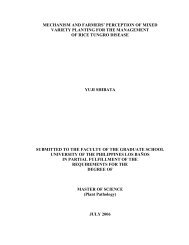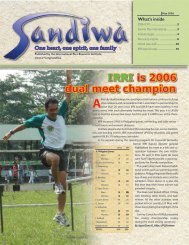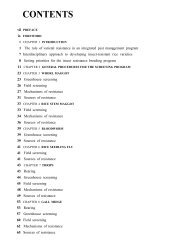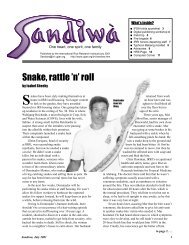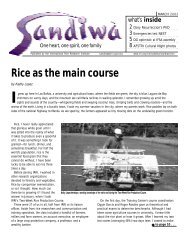Untitled - International Rice Research Institute
Untitled - International Rice Research Institute
Untitled - International Rice Research Institute
Create successful ePaper yourself
Turn your PDF publications into a flip-book with our unique Google optimized e-Paper software.
Observed frequency (%)<br />
120<br />
100<br />
80<br />
60<br />
40<br />
20<br />
0<br />
Sterile<br />
lemmas<br />
Awn<br />
Partition<br />
bet. lemma<br />
and palea<br />
Entire<br />
se ed<br />
Lemma/<br />
palea<br />
only or<br />
both<br />
Seed part<br />
Fig. 16. Observed frequency of Cercospora janseana<br />
occurrence on the seed.<br />
Fig. 17. Plate cultures of Cercospora janseana (Racib)<br />
Const. showing colony growths of PDA, PJA, and VJA<br />
incubated at ART, 21 °C, and 28 °C at 15 d after<br />
inoculation.<br />
Colony characters on culture media (Fig. 17)<br />
Colonies on PDA at ART (28–30 °C) grow very<br />
slowly and attain a 2.40-cm diam in 17 d. They are<br />
azonated, plane to slightly felted, with sinuate margins,<br />
slightly radial furrows, and dark gray. The<br />
colony appears azonated with radial wrinkles and<br />
black on the reverse side of the agar plate. At 21 °C<br />
under alternating 12-h NUV light and 12-h darkness,<br />
colonies grow very slowly and attain a 2.60-cm diam<br />
in 17 d. They are zonated, plane to felted, with sinuate<br />
margins and radial furrows, and gray and light<br />
gray at the margins. The colony appears azonated<br />
with radial wrinkles and black on the reverse side of<br />
the agar plate. At 28 °C under alternating 12-h fluorescent<br />
light and 12-h darkness, colonies are restricted<br />
in growth and attain a 1.4-cm diam in 17 d.<br />
They are zonated, felted, with even to sinuate margins<br />
and deep radial furrows, and light gray. The<br />
colony appears azonated with wrinkles and black on<br />
the reverse side of the agar plate.<br />
Colonies on prune juice agar (PJA) at ART (28–<br />
30 °C) grow very slowly and attain a 2.40-cm diam in<br />
17 d. They are azonated, plane, powdery to granular<br />
with slightly radial furrows and even margins, and<br />
dark gray to gray and becoming light at the margins.<br />
The colony on the reverse side of the agar plate appears<br />
azonated and black. At 21 °C under alternating<br />
12-h NUV light and 12-h darkness, colonies grow<br />
slowly and attain a 3.10-cm diam in 17 d. They are<br />
slightly zonated, plane, granular, and gray with 0.5-<br />
cm white margins. The colony on the reverse side of<br />
the agar plate appears azonated and black with orange<br />
coloration. At 28 °C under alternating 12-h fluorescent<br />
light and 12-h darkness, colonies grow slowly<br />
and attain a 3.20-cm diam in 17 d. They are plane,<br />
zonated with radial furrows and sinuate margins, and<br />
light gray to gray. The colony on the reverse side of<br />
the agar plate appears azonated with radial wrinkles<br />
and black.<br />
Colonies on V-8 juice agar (VJA) at ART (28–30<br />
°C) are restricted in growth and attain a 2.20-cm<br />
diam in 17 d. They are zonated, felted, with sinuate<br />
margins and deep radial furrows, and light gray to<br />
gray with dark gray margins. The colony on the reverse<br />
side of the agar plate appears azonated with<br />
wrinkles and black. At 21 °C under alternating 12-h<br />
NUV light and 12-h darkness, colonies grow very<br />
slowly and attain a 2.30-cm diam in 17 d. They are<br />
zonated, felted, with even to sinuate margins and<br />
deep radial furrows, and light gray to dark gray. The<br />
colony on the reverse side of the agar plate appears<br />
azonated with wrinkles and black. At 28 °C under<br />
alternating 12-h fluorescent light and 12-h darkness,<br />
colonies grow very slowly and attain a 2.30-cm diam<br />
in 17 d. They are zonated with deep radial furrows<br />
and sinuate margins, felted, and brownish gray. The<br />
colony on the reverse side of the agar plate is<br />
azonated with radial wrinkles and black.<br />
23



